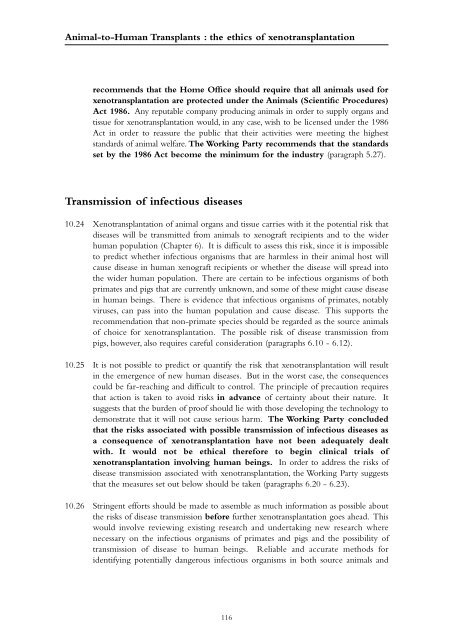Xenotransplantation - Nuffield Council on Bioethics
Xenotransplantation - Nuffield Council on Bioethics
Xenotransplantation - Nuffield Council on Bioethics
Create successful ePaper yourself
Turn your PDF publications into a flip-book with our unique Google optimized e-Paper software.
Animal-to-Human Transplants : the ethics of xenotransplantati<strong>on</strong><br />
recommends that the Home Office should require that all animals used for<br />
xenotransplantati<strong>on</strong> are protected under the Animals (Scientific Procedures)<br />
Act 1986. Any reputable company producing animals in order to supply organs and<br />
tissue for xenotransplantati<strong>on</strong> would, in any case, wish to be licensed under the 1986<br />
Act in order to reassure the public that their activities were meeting the highest<br />
standards of animal welfare. The Working Party recommends that the standards<br />
set by the 1986 Act become the minimum for the industry (paragraph 5.27).<br />
Transmissi<strong>on</strong> of infectious diseases<br />
10.24 <str<strong>on</strong>g>Xenotransplantati<strong>on</strong></str<strong>on</strong>g> of animal organs and tissue carries with it the potential risk that<br />
diseases will be transmitted from animals to xenograft recipients and to the wider<br />
human populati<strong>on</strong> (Chapter 6). It is difficult to assess this risk, since it is impossible<br />
to predict whether infectious organisms that are harmless in their animal host will<br />
cause disease in human xenograft recipients or whether the disease will spread into<br />
the wider human populati<strong>on</strong>. There are certain to be infectious organisms of both<br />
primates and pigs that are currently unknown, and some of these might cause disease<br />
in human beings. There is evidence that infectious organisms of primates, notably<br />
viruses, can pass into the human populati<strong>on</strong> and cause disease. This supports the<br />
recommendati<strong>on</strong> that n<strong>on</strong>-primate species should be regarded as the source animals<br />
of choice for xenotransplantati<strong>on</strong>. The possible risk of disease transmissi<strong>on</strong> from<br />
pigs, however, also requires careful c<strong>on</strong>siderati<strong>on</strong> (paragraphs 6.10 - 6.12).<br />
10.25 It is not possible to predict or quantify the risk that xenotransplantati<strong>on</strong> will result<br />
in the emergence of new human diseases. But in the worst case, the c<strong>on</strong>sequences<br />
could be far-reaching and difficult to c<strong>on</strong>trol. The principle of precauti<strong>on</strong> requires<br />
that acti<strong>on</strong> is taken to avoid risks in advance of certainty about their nature. It<br />
suggests that the burden of proof should lie with those developing the technology to<br />
dem<strong>on</strong>strate that it will not cause serious harm. The Working Party c<strong>on</strong>cluded<br />
that the risks associated with possible transmissi<strong>on</strong> of infectious diseases as<br />
a c<strong>on</strong>sequence of xenotransplantati<strong>on</strong> have not been adequately dealt<br />
with. It would not be ethical therefore to begin clinical trials of<br />
xenotransplantati<strong>on</strong> involving human beings. In order to address the risks of<br />
disease transmissi<strong>on</strong> associated with xenotransplantati<strong>on</strong>, the Working Party suggests<br />
that the measures set out below should be taken (paragraphs 6.20 - 6.23).<br />
10.26 Stringent efforts should be made to assemble as much informati<strong>on</strong> as possible about<br />
the risks of disease transmissi<strong>on</strong> before further xenotransplantati<strong>on</strong> goes ahead. This<br />
would involve reviewing existing research and undertaking new research where<br />
necessary <strong>on</strong> the infectious organisms of primates and pigs and the possibility of<br />
transmissi<strong>on</strong> of disease to human beings. Reliable and accurate methods for<br />
identifying potentially dangerous infectious organisms in both source animals and<br />
116
















